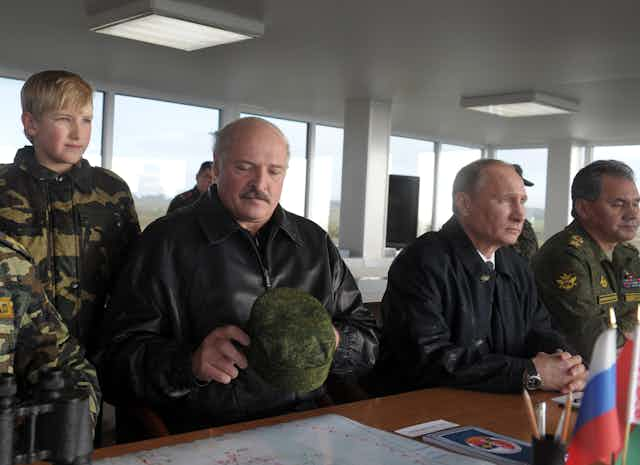Russia is reported to have deployed nuclear weapons in Belarus, a step that was much telegraphed earlier this year and recently confirmed by Poland. This move has caused concern in neighbouring countries and has affected security arrangements in Europe.
Russia reportedly has the world’s biggest nuclear arsenal, with (as of 2023) 5,889 nuclear warheads compared to 5,244 deployed by the US. But size (or, more accurately, numbers of warheads) should not be important.
Nuclear deterrence theory – with its related notion of mutually assured destruction – should mean no country wants to fire weapons first as it would pretty much guarantee their own destruction (along with much of the rest of the planet).
That said, the rhetoric from the Russian leadership since the invasion of Ukraine has regularly raised the threat of Russia’s nuclear stockpile. Both Vladimir Putin and the deputy chair of his national security council (and former president), Dmitry Medvedev, have made threatening comments, including this from Putin in September 2021: “If the territorial integrity of our country is threatened, we will without doubt use all available means to protect Russia and our people – this is not a bluff.”
Different classes of nuclear weapons
This idea of mutually assured destruction is linked to strategic nuclear weapons – which can be used to strike big targets – such as cities – more than 3,500km away and carry huge payloads.
But the weapons reportedly being stationed in Belarus by Russia are tactical nuclear weapons (TNWs). It’s estimated that Russia has 2,000 working tactical warheads, and currently it is not clear how many will ultimately end up in Belarus.
There has been a long debate about what the term TNW means. In 2018, then US defense secretary Jim Mattis, said: “I don’t think there is any such thing as a ‘tactical nuclear weapon.’ Any nuclear weapon used any time is a strategic game-changer”.
The International Campaign to Abolish Nuclear Weapons (ICAN) defines a TNW as “any weapon that’s not been classified as "strategic” under US-Russian arms control agreements (Salt, Sort, Start).“ According to ICAN, these weapons can have explosive yields of up to 300 kilotons, or 20 times the force of the bomb that destroyed Hiroshima.
In terms of delivery, they tend to have a shorter range of around 310 miles and can be delivered by missiles, torpedoes or dropped from aircraft. They are designed to be used on the battlefield. Russia is thought to have about ten times as many tactical nuclear warheads as Nato.
Russia’s nuclear policy
Current Russian nuclear doctrine, outlines four cases in which it would use its nuclear weapons. The first three cases are currently largely inapplicable given no one is attacking or threatening Russia with ballistic missiles or nuclear weapons.

The last case is rather intriguing though. It says that Russia would use its nuclear weapons in case of "aggression against the Russian Federation with the use of conventional weapons when the very existence of the state is in jeopardy”. It is worth breaking down this scenario.
First of all, the concept of aggression means different things to Russia than to others. For example, Russia sees Nato’s enlargement as a hostile act.
Second, Russia has a different interpretation of what Russian territory entails, as the sham referendums organised by Russia occupied by Russian troops indicate. So retaking parts of Ukraine now seen by Moscow as Russian territory could count as “aggression against the Russian federation” under the guidelines.
Then there is Russia’s often contested policy of “escalate to de-escalate”. This essentially means that a key part of Russia’s nuclear doctrine holds that to de-escalate a non-nuclear (conventional) conflict, Russia would have to escalate it first through the threat of a limited or tactical nuclear strike.
This raises the questions of whether, if Russia’s war in Ukraine is in danger of failing altogether, the Kremlin might interpret the prospect of losing as a motivation to invoke this principle.
Medvedev expressed this most clearly in July when he said: “Imagine if the … offensive, which is backed by Nato, was a success and they tore off a part of our land, then we would be forced to use a nuclear weapon according to the rules of a decree from the president of Russia. There would simply be no other option.”
So the Kremlin’s decision to deploy some of its tactical weapons to Belarus gives these concerns an added dimension. Belarus president, Alexander Lukashenko, has warned about what he called “the rapid militarisation of eastern Europe and the increased military activities of the US and Nato”.
On a separate occasion he commented that: “God forbid I have to make a decision to use those weapons today, but there would be no hesitation if we face an aggression.” But it is generally accepted that any decision regarding the weapons would be taken in Moscow rather than Minsk.
Russia’s nuclear forces have been on “high alert” since February 2022, days after the invasion began. The country’s leaders have repeatedly warned of the possibility of their use. And now Moscow has deployed warheads in its client-state neighbour.
US president Joe Biden gave a fairly clear indication of his thoughts when he told political donors in California in June: “When I was out here about two years ago saying I worried about the Colorado river drying up, everybody looked at me like I was crazy. They looked at me like when I said I worry about Putin using tactical nuclear weapons. It’s real.”

